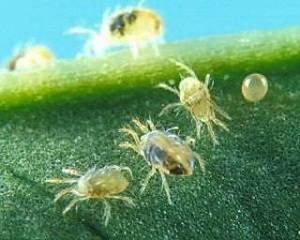When Spider Mites Attack
Spider mites are small bugs that will suck your plants dry. They can quickly become a problem for any indoor gardener. Warm, dry temperatures create the perfect climate for the spider mite’s reproductive cycle. These small bugs can over run your garden and suck the life out of your plants in no time flat.

Identifying Spider Mites
The best way to identify these critters is to look under the leaves of your plants. There are basically 2 types of spider mites. The first type are small and black. The second type are red with black spots.
They lay eggs after they mature which is usually about 2 weeks after hatching. A female can lay thousands of eggs over their lifetime. Eggs hatch in about 3 days.
Once the spider mites have appeared in your indoor garden, they can multiply very quickly. So you must move fast.
If you find that you have a spider mite infestation on your hands, then find the plant or plants that have the most damage and isolate that plant from the rest of the garden. This can help you to quickly gain control of the pests that have infiltrated your garden.
Options for Spider Mites
Pyrethrum is a miticide that is made from chrysanthemum flowers. Pyrethrum will work on contact. It is also safe to use up until harvest time. So this should be your first choice if you have a real infestation on your hands.
Insecticidal soap is another possibility for getting rid of spider mites. This works by penetrating and clogging body membranes. Ivory liquid dish soap, Castile soap and Murphy’s Oil soap are soft soaps that will work but they are not as potent or effective as commercial insecticidal soaps.
Neem oil also works for spider mites, but I’ve found this to work better as a preventative measure. Once these critters have begun setting up webs and small communities on and around your plants, this usually means that it is very late in the game and you must act fast. At this point I’ve found neem oil to be ineffective.
Bug warfare or using beneficial insects such as ladybugs, praying mantis or other predators is yet another option. This also seems to work best when used as a preventative measure. If you have a real infestation on your hands then this option probably won’t help much.
Of course prevention is the best answer. Keeping the grow room clean and sanitary will help to keep harmful bug populations under control. Being aware of any bugs in your garden can also be very helpful in preventing infestations. Taking the time out every few days to examine your plants carefully will help you to identify potential bug infestations BEFORE they happen.
As a preventative measure when growing indoors, I usually spray or dip the plants in a miticide or neem oil just before the start of their vegetative cycle. Then about 3-6wks later just after the flowering cycle begins I will usually spray again. This usually is enough to prevent bugs from appearing until harvest time.
As I’ve mentioned before, there is no substitute for vigilance. Take the time to care for your plants’ needs and you’ll be rewarded with a great harvest.
Many people have also come up with their own home made recipes.
Please comment below if you’d like to share your home made recipe for killing spider mites.
Happy Growing!